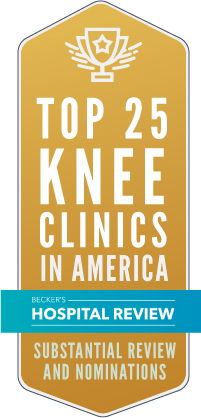Management
Non-Surgical Care
The initial management for most articular cartilage lesions consists of rest, activity modification, anti-inflammatory medications, and physical therapy. Injections in the form of steroids or viscosupplementation may help decrease inflammation and improve symptoms in certain patients. Newer injections include various orthobiologic agents such as platelet-rich plasma (PRP), bone marrow aspirate concentrate (BMAC), amniotic membrane-derived mesenchymal stem cells (MSC), and adipose-derived MSCs. While early studies have demonstrated promising results with these emerging options, additional high-level randomized controlled trials are warranted. A special unloader brace can be effective by relieving pressure from the side of the knee affected by the cartilage defect. Patients who continue to be symptomatic despite conservative measures should be evaluated for possible surgical intervention. Age, activity level, patient expectations, defect size, and associated injuries are all important factors in determining whether or not someone is a surgical candidate. Patients who are considered surgical candidates must understand that many of the cartilage restoring procedures require extensive rehabilitation and that they will be unable to return to activities for extended periods.
Surgical Care
Arthroscopic Debridement
Arthroscopic debridement is a common first choice for surgery. The goal of the surgery is to reduce inflammation, remove loose pieces, and address unstable cartilage fragments. It can be a useful procedure for patients who may not be good candidates for cartilage restoration or who would be unwilling to participate in extensive post-operative rehabilitation. This is a minimally invasive procedure that is typically performed through two very small incisions or poke holes. A small camera is inserted and instruments are used to clean the knee while removing loose fragments of cartilage and creating a smooth surface. Patients can bear full weight after this procedure and can return to full athletic activity in as soon as 4-6 weeks.
Microfracture
Microfracture is commonly performed for small cartilage defects. The procedure can be performed through arthroscopy, a mini-open approach or an open approach. Arthroscopy and mini-open methods are most frequently used. The microfracture technique involves using an arthroscopic shaver to remove injured cartilage while maintaining healthy cartilage. The bone is then penetrated multiple times to allow cells from the bone marrow to assist the body in repairing the injured tissue. Post-operative rehabilitation typically involves toe-touch weight-bearing for a period of 4-6 weeks. Some surgeons will allow patients to bear weight as tolerated with a special brace. Motion is reintroduced over time. The goal is to return patients to sports activity around 6 to 9 months. Historical studies have concluded that microfracture can offer good clinical results for small lesions at short- and long-term follow-up, but clinical outcomes may deteriorate over time.
Osteochondral Autograft Transfer
This technique involves taking small amounts of bone and cartilage from low-weight-bearing parts of the femur (thigh bone) within the knee and transferring them to the higher-weight-bearing area of injury. This grafting can be performed through arthroscopy, open technique or mini-open technique through a small incision. Often, arthroscopy is used for diagnosis, and then a mini-open approach is used to complete the procedure. The size and shape of the defect is determined, and it is prepared using the appropriate equipment. The area of the femur from which the grafting material will be taken will be selected based on the size and shape of the injured area. A harvesting chisel is used to remove the tissue, which is then inserted into the prepared area. One of the main advantages of this procedure is that it results in mature, healthy cartilage at the defect site. In addition, it can successfully be used to correct bone loss or an abnormality. However, it can negatively affect the area from which material is harvested, and the amount of material available can be limited. Therefore, this approach is best for correcting small defects. Post-operative rehabilitation consists of toe-touch weight-bearing for 4 to 6 weeks, depending on the extent of grafting performed. Early, progressive motion is encouraged and a return to athletic activity is delayed for 4 to 6 months. Most studies report favorable results with this technique but smaller defects tend to do better than larger defects.
Osteochondral Allograft Transplantation
This technique is similar to that of osteochondral autograft transfer, but it involves taking a larger amount of tissue from a cadaver rather than from the patient’s own knee. This procedure is an excellent option for larger defects. It also can be successfully used to correct a previously failed cartilage repair surgery. Freshly obtained grafting material, as opposed to frozen or freeze-dried specimens, is used to help ensure the best outcome. Ideally, the graft material is taken from the same location as the patient’s defect and is roughly the same size. To perform this procedure, the surgeon makes an open incision and identifies the defect. Once the size has been determined, the surgeon removes the abnormal cartilage and a small amount of bone, creating a tunnel. Then, the fresh donor material is obtained. The surgeon attempts to obtain donor material that matches the size and shape of the patient’s tunnel. The donor material is then inserted in the tunnel. Post-operative rehabilitation consists of toe-touch weight-bearing for 4 to 6 weeks. Early progressive motion is encouraged. High-impact activities, such as running and jumping, should be avoided until 4 to 6 months after surgery. Osteochondral allograft transplantation has been performed for the past 50 or more years with several studies demonstrating satisfactory outcomes. In 80-90 percent of patients, grafts survive at least 10 years. At 20 and 25 years post-surgery, grafts remain in up to 60-70 percent of patients.
Matrix-Induced Autologous Chondrocyte Implantation
Matrix-induced autologous chondrocyte implantation (MACI) can be used to restore knee cartilage in cases of medium to large defects. MACI is a two-stage procedure. In the first stage, arthroscopy is performed to evaluate the size and location of the defect. If the surgeon determines that MACI is appropriate, a sample of cartilage is taken from a non-weight-bearing part of the knee. This sample tissue then is sent to a lab, where cells are removed and expanded over 4 to 6 weeks through a special procedure. The second stage involves implanting the expanded cells back into the area of the defect. This can be performed within 4 to 6 weeks, or the cells can remain frozen for up to two years if implantation is delayed. The surgeon may implant the expanded cells through an open incision or arthroscopy, depending on the size and location of the defect being treated. At the time of re-implantation, the new material, called the MACI membrane, is trimmed to the desired size and shape, and secured to the bone with a special glue. Sutures might also be used to attach the material to the stable surrounding rim of cartilage. Post-operative rehabilitation starts with immediate motion. A special machine is used for 6 to 8 hours a day for the first 6 weeks to move the patient toward a 90-degree knee bend. Depending on the type of defect, the patient may remain toe-touch weight-bearing for 6 weeks and then progress towards weight-bearing as tolerated, or may be full weight-bearing with full extension as tolerated immediately after surgery. Running and strenuous sports activity is not allowed for 9-12 months. Five-year outcomes reveal success rates of 90 percent or greater. Longer-term (10 to 20 years) outcomes have reported success rates of 70 to 75 percent.
Meniscus repair/transplantation
The meniscus is “C” shaped structure that sits between the tibia and femur. It functions as a shock-absorber to protect the articular cartilage. The articular cartilage is the smooth surface at the ends of the femur and tibia inside the joint. The meniscus can be damaged and torn in acute trauma or gradually wear out as a result of degeneration. Meniscus tears can be repaired with sutures in order to preserve the structures function. Some meniscus tears are unable be repaired and have to be “cleaned up” by surgically removing the torn pieces. If patients continue to have pain as a result of missing portions of their meniscus then meniscus transplant surgery can be considered. Rehabilitation following meniscus repair and transplantation surgery consists of crutches for 2-6 weeks followed by progress weight bearing, range of motion exercises, and strengthening. Return to full athletic activity and sports usually occurs between 4-6 months following meniscus repair.
Osteotomy
Normal alignment of the knee is when the forces through the knee joint are evenly distributed. Occasionally people can develop malalignment. This can be congenital, degenerative, or due to trauma. If the malalignment causes or contributes to pain, realignment surgery can be performed in the form of an osteotomy procedure. In this procedure the malaligned bone is cut, realigned, and secured with a plate. Sometimes the realignment procedure is performed in conjunction with a ligament reconstruction, meniscus repair/transplantation, or articular cartilage procedure. The most common osteotomy procedures of the knee include the femur, tibia, or tibial tubercle. Healing of the bone occurs over 6-12 weeks and there is a need for crutches during a period of that time.
When the Best Matters




CSMOC is an award-winning center for orthoapedic treatment in Cincinnati.
